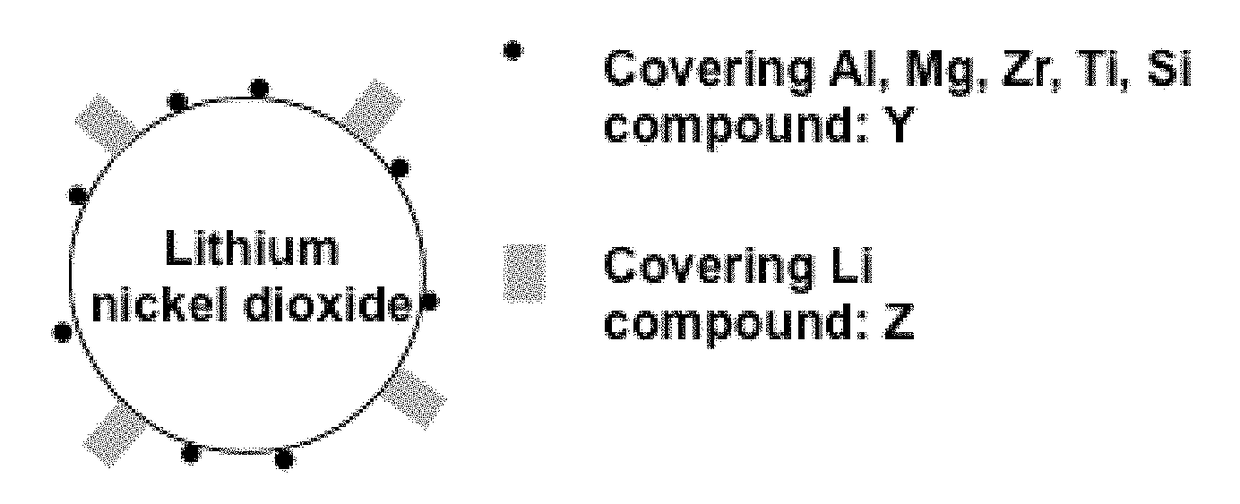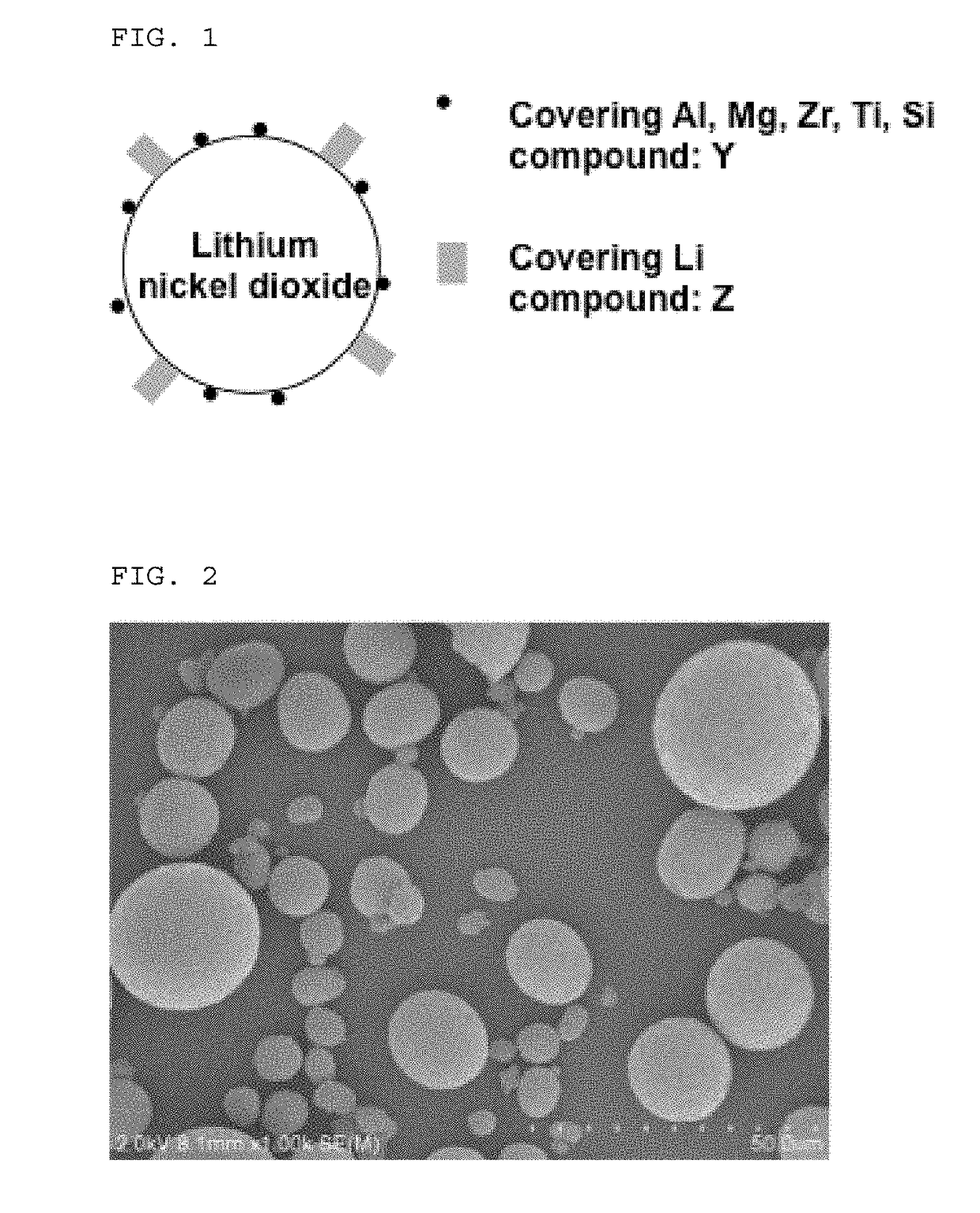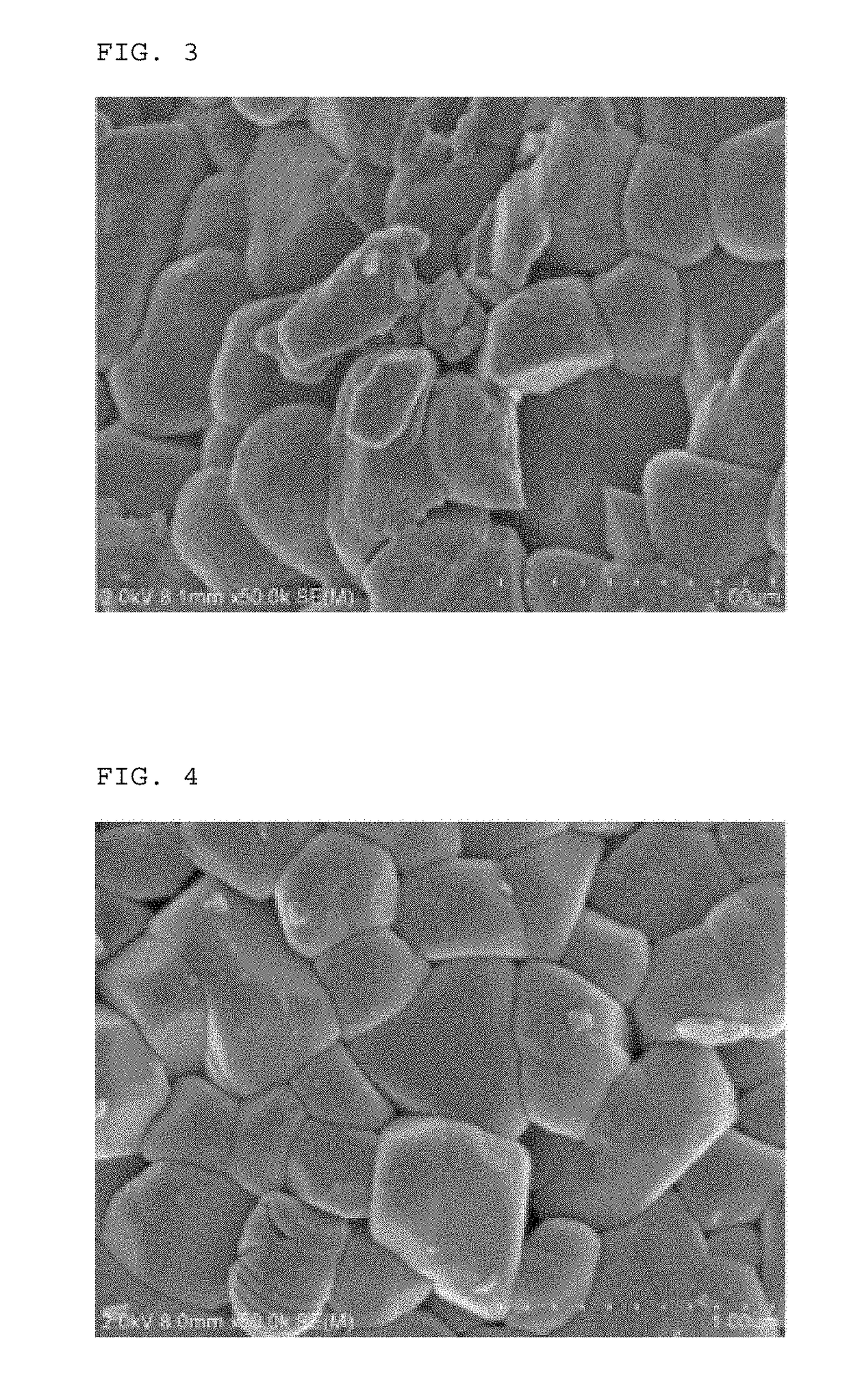Lithium nickelate-based positive electrode active substance particles and process for producing the same, and non-aqueous electrolyte secondary battery
a positive electrode and active substance technology, applied in the field of lithium process for producing the same, can solve the problems of deterioration in prone to structural defects, and conventional lithium nickelate-based positive electrode active substance particles that have not had such a high stability, etc., to achieve excellent repeated charge/discharge cycle characteristics, suppressed side reactions therebetween, and excellent effect of repeated charge/discharg
- Summary
- Abstract
- Description
- Claims
- Application Information
AI Technical Summary
Benefits of technology
Problems solved by technology
Method used
Image
Examples
example 1
[0076]Cobalt-containing nickel hydroxide Ni0.84Co0.16(OH)2 as a precursor was obtained by a crystallization method via an ammonia complex in a water solvent over several days. The cobalt-containing nickel hydroxide, lithium hydroxide monohydrate LiOH.H2O and aluminum hydroxide Al(OH)3 were weighed in predetermined amounts such as the molar ratio between elements Li, Ni, Co and Al therein was Li:Ni:Co:Al=1.02:0.81:0.15:0.04. Thereafter, these compounds were mixed each other using a high-speed mixer, and the resulting mixture was calcined in an oxygen atmosphere at 770° C. using a roller hearth kiln, thereby obtaining a lithium nickelate composite oxide capable of forming a core particle X.
[0077]Thirty grams of the thus obtained lithium nickelate composite oxide particles were allowed to stand for 6 hr while flowing atmospheric air having a temperature of 20° C. and a relative humidity of 21% at a rate of 80 ft / min therethrough to transform LiOH included in the particles into LiOH.H2O...
example 2
[0099]Using the lithium nickelate composite oxide Li1.02Ni0.81Co0.15Al0.04O2 having a layer structure capable of forming the core particle X which were obtained in Example 1, a coating compound Y was formed by atomic layer deposition method. The treating conditions used in the atomic layer deposition method were the same as those used in Example 1, i.e., trimethyl aluminum Al2(CH3)6 was used as the raw material gas A, and H2O was used as the raw material gas B, and these raw materials were subjected to 4 cycle treatment at 180° C. Thereafter, while flowing air having a temperature of 20° C. and a relative humidity of 21% at a rate of 80 ft / min, the resulting material was subjected to humidification treatment for 6 hr, and then treated in atmospheric air at 350° C. for 2 hr, thereby producing the coating compound Z.
[0100]As shown in FIG. 6(2) showing a profile in a depth direction of XPS of the resulting lithium nickelate-based positive electrode active substance particles, large amo...
example 3
[0106]Cobalt-containing nickel hydroxide Ni0.84Co0.16(OH)2 as a precursor was obtained by a crystallization method via an ammonia complex in a water solvent over several days. The subsequent procedures were conducted in the same manner as in Example 1 to obtain Li1.02Ni0.81Co0.15Al0.04O2 core particle. A coating compound Y was formed by atomic layer deposition method. The atomic layer deposition method was conducted in the same manner as in Example 1. Thereafter, while flowing air having a temperature of 20° C. and a relative humidity of 21% at a rate of 80 ft / min, the resulting material was subjected to humidification treatment for 6 hr and then treated in atmospheric air at 350° C. for 2 hr, thereby producing the coating compound Z. The powder characteristics of the lithium nickelate-based positive electrode active substance particles obtained in Examples 3 to 7 and Comparative Examples 5 to 14 as well as battery characteristics thereof are shown in Table 2, 3, and 4.
PUM
| Property | Measurement | Unit |
|---|---|---|
| Temperature | aaaaa | aaaaa |
| Percent by mass | aaaaa | aaaaa |
| Percent by mass | aaaaa | aaaaa |
Abstract
Description
Claims
Application Information
 Login to View More
Login to View More - R&D
- Intellectual Property
- Life Sciences
- Materials
- Tech Scout
- Unparalleled Data Quality
- Higher Quality Content
- 60% Fewer Hallucinations
Browse by: Latest US Patents, China's latest patents, Technical Efficacy Thesaurus, Application Domain, Technology Topic, Popular Technical Reports.
© 2025 PatSnap. All rights reserved.Legal|Privacy policy|Modern Slavery Act Transparency Statement|Sitemap|About US| Contact US: help@patsnap.com



